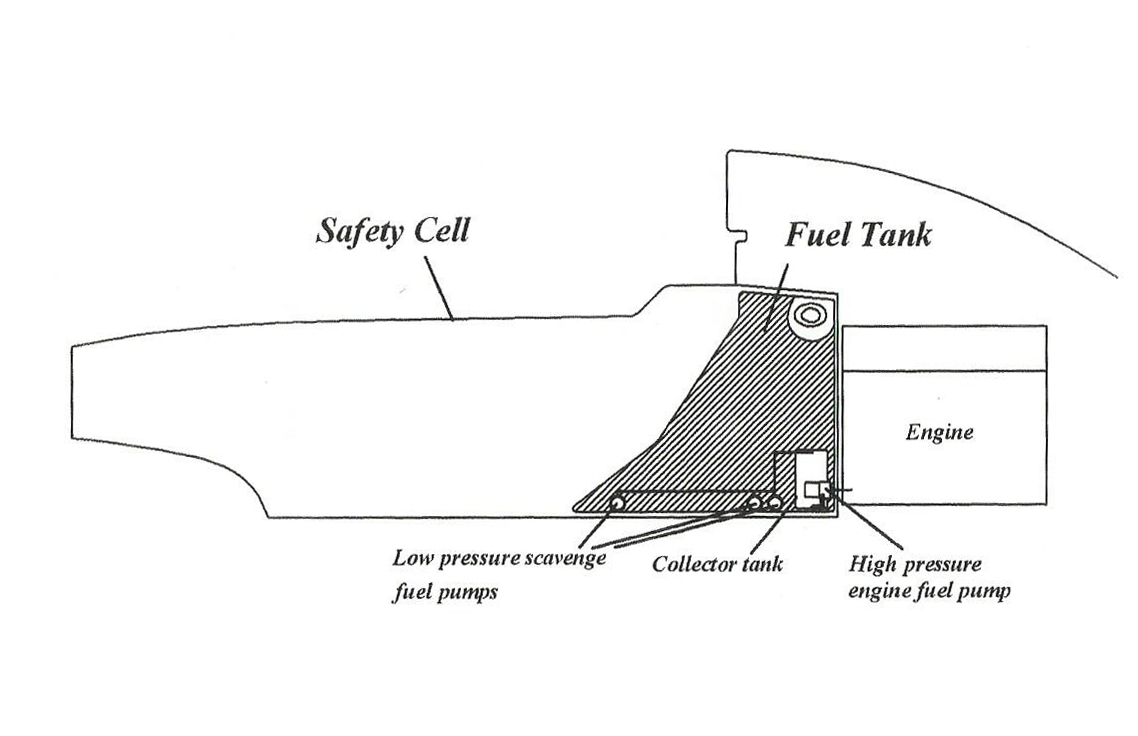The fuel tank
Few who have ever witnessed a vehicle fire, let alone one in a Grand Prix machine, will ever forget the foreboding, the simple sheer terror of it all, and with it the intense heat, once alight and without proper fire-fighting equipment, as bystanders we can do very little. As a youth I still remember watching on television Lorenzo Bandini’s fiery demise at the 1967 Monaco race and Roger Williamson’s in Holland some five years later. Such images are still indelibly printed in my mind.
That we no longer see such incidents is a testament to the efforts of the FIA and the concept of the ‘survival cell’ encompassing both driver cockpit and fuel tank. So whereas the fuel tank of Bandini’s Ferrari was made entirely of aluminium and ruptured during the accident, modern Formula One fuel tanks consist of a flexible bladder surrounded by a crushable structure within the carbon fibre bodywork of the vehicle, and are therefore much more robust.
Conforming to regulation FIA/FT5-1999, the bladder itself is made from Kevlar, a proprietary product developed by the chemical giant DuPont in the 1960s, the same basic material now for anti-stab or bullet-proof vests. It consists of aramid fibres (a bit like nylon but far stronger) which are woven into a cloth-like material and coated with a fuel-resistant elastomer on both sides. Assembled, bonded and cured, the bladder has to be flexible enough to be inserted into the void within the survival cell through a small aperture, generally on the underside of the chassis. The exact process, elastomers and bonding agents used are a closely guarded secret, since they affect the degree to which the cell can be compressed and hence the size of the aperture needed. The greater the size of the aperture the more this will affect the ultimate stiffness of the tub, and so, as in anything concerning Formula One, the pressure is on to make the aperture as small as possible.
Once inside the tub though, and located by the fuel filler aperture and the flange required to run the mechanical fuel pump inside the tank – and maybe one or two other fasteners – final assembly is rather like putting a model ship in a bottle. For in order to control the movement of the fuel under the forces of acceleration, braking and cornering, various baffles and one-way trapdoors have to be inserted once the bladder is in position. Placed horizontally to prevent the fuel from rising up, and vertically to control its lateral movement, these ensure that the fuel can be pumped from any part of the tank to the collector tank feeding the main high-pressure fuel pump under all and particularly low fuel conditions. Partially assembled while the bladder is in manufacture, these baffles are made from a similar but slightly more flexible material than the bladder itself, and finally erected once the bladder is in place. The trapdoors so necessary to swing open and then trap the fuel as it attempts to flow back are made from a rigid carbon fibre.
With its low-pressure scavenge pumps, high-pressure mechanical fuel pump, filler pipes, breather systems, and return hoses, as well as the system of baffles and trapdoors, a modern Formula One fuel tank weighing something in the region of 5 kg is a complex affair. But since it was 1989 when Gerhard Berger was the last driver to be burned in an on-track incident, something somewhere must be right. So while the FIA may be criticised for its continual interference with the rules and regulations of the sport, thank heavens for the fuel tank safety bladder.
 Fig. 1 - Formula One safety cell
Fig. 1 - Formula One safety cell
Written by John Coxon